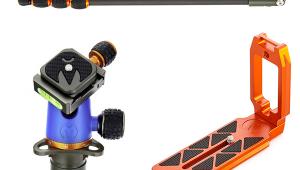7 Reasons You Should Use a Tripod

If you never use a tripod, there are a few photographic techniques you’re not using. Why miss big chunks of the fun?

Called everything from a lifesaver to an anchor, our ever-faithful three-legged friends stand at the ready, eager to provide some rock-solid support even to the shakiest camera shooters. Despite the undeniable benefits tripods deliver, some photographers avoid them like kids avoid Brussels sprouts (who cares if they’re good for you?). The naysayers’ reasons are just rationalizations, I contend, and include myths and half-truths, some of which may have applied to equipment from long ago, but melted away with the introduction of new materials and designs.
Too big, too heavy, too slow—not talking about your dance partner, these are three common complaints about tripods. But to counter these I offer the line I’ve repeated for decades: a tripod is the only accessory that can improve every picture you take. And Brussels sprouts ain’t half bad, neither.
If you’ve been wanting to buy a tripod but need a 5-minute briefing to prepare for the nomenclature, feature traps and caveats, read our Buyer’s Guide, What Type of Tripod Should I Buy? Buying Advice: How to Buy a Tripod.
Not convinced yet? Okay. Here are seven reasons you should use a tripod.

1. Better Than Image Stabilization
Many cameras have IS built in, and if they don’t it’s highly likely that their lenses do. Stabilization is everywhere. Let’s pause a moment to salute my late, great alma mater, Minolta, the company that introduced Anti Shake (as we named it) with the Minolta DiMAGE A1 back in 2003. Yup, 19 years ago Minolta offered to the world the first consumer-level digital camera with sensor-based Image Stabilization.
IS helps. It helps a lot. But the maximum benefit you might get is around six f/stops, and that’s pushing it. In essence, IS increases the length of time you can keep the shutter open before camera shake (slight vibration) degrades image quality. None of today’s Image Stabilization systems enable shutter speeds measured in full seconds. However, by using a tripod you can shoot with the shutter open for minutes, even hours.
Ergo, tripods trump stabilization.
 2. Not As Cumbersome As Your Dad’s Tiltall
2. Not As Cumbersome As Your Dad’s Tiltall
The original milled aluminum plus stainless steel Tiltall tripod weighed more than six pounds. That’s almost as much as a gallon of milk! On the other hand, it supported 44 pounds of raw weight and could be used to fight off an attacking bear (although not recommended). The Tiltall was a badge of honor among ardent photographers—not owning one, just having the stamina to carry and use one for more than 30 minutes.
 Today there are many high quality, light-weight tripods that are easy to carry and easy to put into action. For example, you can buy a versatile, highly recommended tripod, the Benro Bat that weighs 4.4 pounds and supports 30. Benro offers a fine line of tripods including the sub-$150 Benro Slim that will change your mind about tripods forever.
Today there are many high quality, light-weight tripods that are easy to carry and easy to put into action. For example, you can buy a versatile, highly recommended tripod, the Benro Bat that weighs 4.4 pounds and supports 30. Benro offers a fine line of tripods including the sub-$150 Benro Slim that will change your mind about tripods forever.

3. Panning
Panning makes a moving subject appear to be standing still while the world streaks past it. To pan effectively, the camera must stay on a plane parallel to the horizon. Simply stated, a tripod that has a panhead allows you to move the camera on the left-to-right axis while locked into place on the up-down-access. While this can be done handheld with practice and luck, using a panning tripod is the only way to assure consistent and pleasant results. And if you’re panning video, don’t even think about trying it sans tripod.

4. Remote Control / Intervalometer
One of the most exciting recent innovations is Remote Capture using a smartphone or tablet to preview the image and control the camera. In essence, the smart device becomes the brains and preview monitor while the camera performs as a dumb capture device.
Similar to this but entirely different, you can also control many advanced cameras via a wireless controller, infrared controller or intervalometer. And of course some cameras have intervalometers built in.
While we’re on this horse, a simple Self Timer is nigh on to worthless without a tripod. And selfies certainly look better without an arm extended from the subject to the camera.

5. L-o-n-g Time Exposures and Macro
As mentioned above, tripods enable long exposures. Intuitively we know that if we want to use extended shutter speeds longer than about ¼ second we need a tripod or other fixed support. However, “long” is relative. If you are shooting macro images where the depth-of-field is measured in nanometers, a shutter speed of even 1/125 second can cause visible degradation of the image. Use a tripod and keep the camera absolutely still. Then find a way to control ambient air movement (breeze) for truly sharp pics.
Use a remote release or old fashioned cable release when shooting sensitive macros. Otherwise your contact with the camera shutter release button can impart vibrations. Lacking a remote release, use the self timer. Many cameras have a 2-second option in addition to the traditional 10-second delay. The 2-second option is provided specifically for the purpose of replacing the remote release.
 6. Slow Down And Compose!
6. Slow Down And Compose!
If you’ve ever used a view camera, you understand this concept. Using a tripod is inherently slower than randomly pointing and clicking a camera; it’s not so slow as to be debilitating, but slow enough to make you chill and take your time.
When shooting a non-moving subject, use a three-legged friend and take extra seconds to compose, and extra seconds to judge the bright and dark areas of the scene. Preview built-in special effects, if that’s your thing. Preview several film simulations if you’re a Fujifilm shooter. Tweak the composition. In short, slow down and build the image bit by bit.

7. Video On Demand
Almost every advanced digital camera has some sort of video capability, certain Leica models being the notable exceptions. Often, switching from still photography to video is as simple as pressing one button, or sliding one switch. That said, video shot without a tripod or gimbal device can be a pain to watch—literally. As the old saying goes, “Anybody can shoot a video but can anybody watch it?”
When you shoot video, do everyone a favor and use a tripod. If you’re shooting a scene that may include stills and video, use a tripod so you can shift seamlessly into video operation without jiggles.
Conclusion
If you want better pictures and more photographic options, use a tripod. Ideally you should have three: one for your studio, one for travel and one for the trunk of your car.
I forgot to mention smartphone photography. Many current tripods accommodate cellphones directly or via an adapter. And there are specially-made selfie sticks and combination tripod-plus-selfie stick contraptions that help improve smartphone videography and photography. Here’s one final shameless plug for a story we wrote a couple years back: The 5 Best Selfie Sticks & Smartphone Camera Tripods.
—Jon Sienkiewicz
(As an Amazon Associate, Shutterbug earns from qualifying purchases linked in this story.)
- Log in or register to post comments

















































